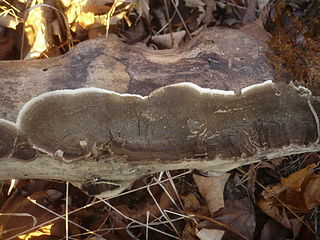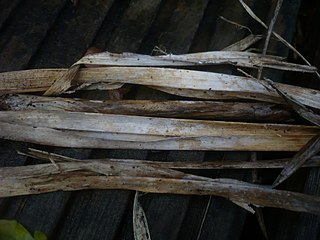
Phanerochaete is a genus of crust fungi in the family Phanerochaetaceae.

The Meruliaceae are a family of fungi in the order Polyporales. According to a 2008 estimate, the family contains 47 genera and 420 species. As of April 2018, Index Fungorum accepts 645 species in the family.

The Phanerochaetaceae are a family of mostly crust fungi in the order Polyporales.

Byssomerulius is a widely distributed genus of crust fungi.
Candelabrochaete is a genus of crust fungi in the family Phanerochaetaceae.

Phlebia is a genus of mostly crust fungi in the family Meruliaceae. The genus has a widespread distribution. Phlebia species cause white rot.
Mycoaciella is a genus of corticioid fungi in the family Meruliaceae. The genus was circumscribed by John Eriksson and Leif Ryvarden in 1978. After microscopic examination of the three species then in the genus, Karen Nakasone proposed to synonymize Mycoaciella with Phlebia.

Mycoacia is a genus of toothed crust fungi in the family Meruliaceae. It was circumscribed by Dutch mycologist Marinus Anton Donk in 1931.

Porostereum is a genus of poroid crust fungi in the family Phanerochaetaceae. It was circumscribed by Czech mycologist Albert Pilát in 1937.

Phlebiopsis is a genus of poroid crust fungi in the family Phanerochaetaceae. The genus contains 11 species, which collectively have a widespread distribution. The genome sequence of the type species, Phlebiopsis gigantea, was published in 2014.
Hjortstamia is a genus of poroid fungi in the family Phanerochaetaceae. It was circumscribed by French mycologists Jacques Boidin and Gilles Liège in 2003. Miettinen and colleagues consider Hjortstamia to be a taxonomy of Phlebiopsis based on molecular phylogenetics.
Australicium is a genus of two species of crust fungi in the family Phanerochaetaceae. The genus was circumscribed by mycologists Kurt Hjortstam and Leif Ryvarden in 2002 to contain the type species, A. singulare, which is found in New Zealand. The Venezuelan species A. cylindrosporum was added to the genus in 2005.

Hydnophlebia is a genus of five species of toothed crust fungi in the family Meruliaceae. All species are wood-decay fungi that cause a white rot.
Pirex is a fungal genus in the family Meruliaceae. It is a monotypic genus, containing the single crust fungus Pirex concentricus. It is found in the Pacific Northwest region of North America, where it causes a white rot in woody hardwood and conifer debris generated by timber harvesting.

Radulodon is a genus of toothed crust fungi in the family Meruliaceae. The genus was circumscribed in 1972 by Norwegian mycologist Leif Ryvarden, with R. americanus as the type species.

Epithele is a genus of crust fungi in the family Polyporaceae.
Grammothele is a genus of poroid crust fungi in the family Polyporaceae.

Xylodon is a genus of crust fungi in the family Schizoporaceae.
Lyoathelia is a fungal genus in the family Atheliaceae. The genus is monotypic, containing the single corticioid (crust-like) species Lyoathelia laxa. Originally found in Canada, it is now known to occur as well in the United States and Japan.
Phanerodontia is a genus of four species of crust fungi in the family Phanerochaetaceae. The genus was circumscribed by mycologists Kurt Hjortstam and Leif Ryvarden in 2010 with Phanerodontia dentata as the type species.












